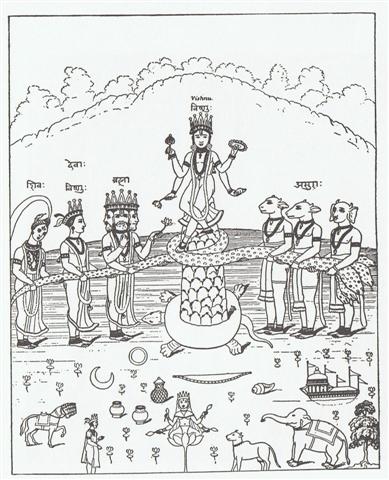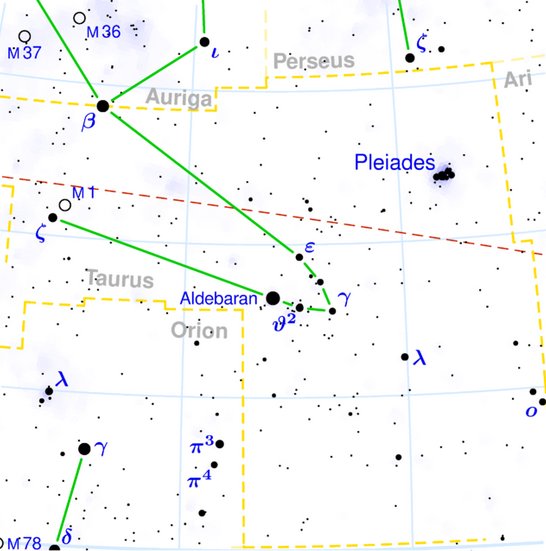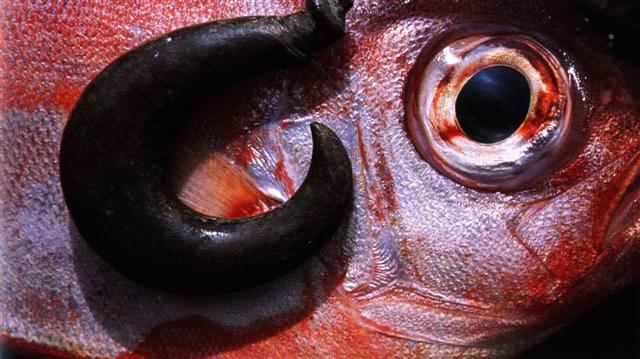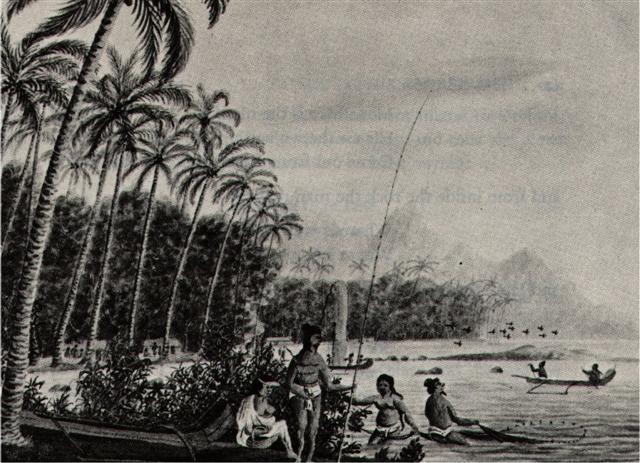Bb8.5
The first glyph in line Bb8-1 looks similar to Vishnu's greater
necklace:

But it is also similar to the form around the nose (→
beginning) of the Head of the Golden Bull
(Taurus):


 |
 |
 |
 |
 |
|
Bb8-1 (285) |
Bb8-2 |
Bb8-3 |
Bb8-4 |
Bb8-5 |
|
Kua hua ia |
ki to inoino - e to huki e |
hakaturou ki ruga
nei |
e tagata - mau maro |
mai tae tuu mai ki te pa - maro |
|
Hua. 1. Testicle. 2.
Figuratively: son, hua tahi, only son; fruits
of the earth; to grow well (of fruits). 3. To cause
a fight, a quarrel. Hua-ai, generation, as
lineage of direct descendents;
contemporaries. Huahua, coccyx of bird, 'parson's nose':
huahua moa, huahua uha. Huataru, a
creeper (Chenopodium ambiguum).
Vanaga. 1. The same; ki hua, again, to
continue, to strain, to struggle, to move, to
repeat, over and above. Mq.: hua, the same,
to return, to recommence. 2. To bloom, to sprout;
flower, fruit (huaa); huaa tae oko,
huaa vahio, young fruit; hua atahi, only
son; huahaga, fruit; mei te huahaga o
tokoe kopu, the fruit of thy body; tikea
huahaga, deceptive appearance. P Pau.: ua,
to be born; huahaga, lineage. Mgv.: hua,
to produce (said of trees, grain, etc.), blooming
time of flowers, abundance of fruit. Mq.: hua,
to produce, to bear fruit. Ta.: ua, to
sprout. Huahua. 1. Tailless fowl. 2. Vein,
tendon, line. 3. Mgv.: huahua, pimples
covering the face. Ta.: huahua, id. Mq.:
hua, tubercules. Sa.: fuafua, abscess on
hand or feet. Ma.: huahua, small pimples.
Pau.: Hua-gakau, rupture. Ta.: áau,
entrails. Sa.: ga'au, id. Ma.: ngakau,
id. Churchill. 1. Fruit. 2. Egg. 3. Tā
hua = 'genealogical writing' or 'same writing'.
Fischer.
Ruga. Upper part, higher part; when used
as a locative adverb, it is preceded by a
preposition: i ruga, above, on; ki ruga,
upwards, mai ruga, from above. When used
with a noun the same preposition is repeated:
he-ea te vî'e Vakai, he-iri ki ruga ki te Ahu ruga,
the woman Vakai went, she climbed Ahu Runga.
Ruga nui, high, elevated, lofty: kona ruga
nui, high place, elevated position, high office;
mana'u ruga nui, elevated thoughts. Vanaga.
High up; a ruga, above; ki ruga, on,
above, upon; ma ruga, above; o ruga,
upper; kahu o ruga, royal (sail); ruga iho,
celestial. Hakaruga, to accumulate, to draw
up. P Pau., Mgv.: ruga, above. Mq.: úna,
úka, id. Ta.: nua, nia, id.
Churchill.
 |
|
May 10 (146 - 16) |
11 |
12 (148 - 16) |
13 (133) |
14 (150 - 16) |
|
ALGENIB PERSEI = α Persei (50.0), ο Tauri (50.2), ξ Tauri (50.8)
GIENAH (γ Corvi) |
σ Persei (51.6) |
No star listed (52) |
ψ
Persei (53.1)
ACRUX (α
CRUCIS) |
δ
Persei (54.7) |
|
Nov 8 |
9 |
10 (314 → π) |
11 |
12 |
|
ο
Cor. Borealis (232.0),
δ
Lupi (232.1),
φ¹,
ν²
Lupi (232.2),
ν¹
Lupi (232.3),
ε
Lupi (232.4),
φ²
Lupi (232.5),
PHERKAD (The Dim One of the Two Calves) =
γ
Ursae Min.
(232.6),
ε
Librae (232.7),
η
Cor. Borealis (232.8),
υ
Lupi (232.9)
*191.0 = *232.4 - 41.4 |
ALKALUROPS (The Herdsman's Lance) =
μ
Bootis
(233.1),
ED ASICH (Male Hyena) =
ι
Draconis
(233.2) |
NUSAKAN (Pauper's Bowl) = β Cor. Bor.
(234.0), κ¹ Apodis (234.3), ν Bootis (234.7), ζ
Librae (234.9 |
θ Cor. Borealis (235.3), γ Lupi (235.6),
GEMMA =
α Cor. Bor.,
ZUBEN ELAKRAB = γ Librae, QIN = δ Serpentis, ε Tr.
Austr. (235.7), μ Cor. Borealis (235.8), υ Librae (235.9)
SIRRAH (α Andromedae) |
φ Bootis (236.2), ω Lupi, τ Librae (236.3), ψ¹ Lupi
(236.7), ζ Cor. Borealis (236.9) |
|
... In other words, the ancient Druidic religion
based on the oak-cult will be swept away by
Christianity and the door - the god Llyr - will
languish forgotten in the Castle of Arianrhod, the
Corona Borealis. This helps us to understand
the relationship at Rome of Janus and the White
Goddess Cardea who is ... the Goddess of Hinges who
came to Rome from Alba Longa. She was the hinge on
which the year swung - the ancient Latin, not the
Etruscan year - and her importance as such is
recorded in the Latin adjective cardinalis -
as we say in English 'of cardinal importance - which
was also applied to the four main winds; for winds
were considered as under the sole direction of the
Great Goddess until Classical times ...
 |
In the G text this type of glyph (puo)
was used to define the
measure *22 right ascension days counted from the Hindu
station
Bharani (Yoni, the female organ of reproduction) to
γ Tauri (Hyadum I):
|
 |
*22.0 |
 |
|
Gb8-8 (220) |
Gb8-30 (242) |
|
May 1 (121) |
May 23 |
|
BHARANI
(*41.4) |
HYADUM I
(*63.4) |
I think these 22 (π) nights corresponded to the goddess
Haumea:
... The 'living god', moreover,
passes the night prior to the dismemberment of
Lono in a temporary house called 'the net house
of Kahoali'i', set up before the temple structure
where the image sleeps. In the myth pertinent to these
rites, the trickster hero - whose father has the same
name (Kuuka'ohi'alaki) as the Kuu-image of
the temple - uses a certain 'net of Maoloha' to
encircle a house, entrapping the goddess Haumea;
whereas, Haumea (or Papa) is also a
version of La'ila'i, the archetypal fertile
woman, and the net used to entangle her had belonged to
one Makali'i, 'Pleiades'. Just so, the succeeding
Makahiki ceremony, following upon the putting
away of the god, is called 'the net of Maoloha',
and represents the gains in fertility accruing to the
people from the victory over Lono. A large,
loose-mesh net, filled with all kinds of food, is shaken
at a priest's command. Fallen to earth, and to man's
lot, the food is the augury of the coming year. The
fertility of nature thus taken by humanity, a
tribute-canoe of offerings to Lono is set adrift
for Kahiki, homeland of the gods. The New Year
draws to a close. At the next full moon, a man (a tabu
transgressor) will be caught by Kahoali'i and
sacrificed. Soon after the houses and standing images of
the temple will be rebuilt: consecrated - with more
human sacrifices - to the rites of Kuu and the
projects of the king ...
... About Carmenta we know from the
historian Dionysus Periergetis that she gave orcales to
Hercules and lived to the age of 110 years. 110 was a
canonical number, the ideal age which every Egyptian
wished to reach and the age at which, for example, the
patriarch Joseph died. The 110 years were made up of
twenty-two Etruscan lustra of five years each;
and 110 years composed the 'cycle' taken over from the
Etruscans by the Romans. At the end of each cycle they
corrected irregularities in the solar calendar by
intercalation and held Secular Games. The secret sense
of 22 - sacred numbers were never chosen haphazardly -
is that it is the measure of the circumference of the
circle when the diameter is 7. This proportion, now
known as pi, is no longer a religious secret; and
is used today only as a rule-of-thumb formula, the real
mathematical value of pi being a decimal figure
which nobody has yet been able to work out because it
goes on without ever ending, as 22 / 7 does, in a neat
recurring sequence [3.142857142857 ...]. Seven lustra
add up to thirty-five years, and thirty-five at Rome was
the age at which a man was held to reach his prime and
might be elected Consul. (The same age was fixed upon by
a Classically-minded Convention as the earliest at which
an American might be elected President of the United
States.) ...
Haumea = Bharani (the Bearer)
= Yoni could then be
depicted in front at Bb7-33:
 |
 |
 |
 |
 |
|
Bb7-32 (275) |
Bb7-33 |
Bb7-34 |
Bb7-35 |
Bb7-36 (700) |
|
i to huki - o to maro |
e tagata - hua era |
e tagata noho |
ki to manu e |
kua moe koe |
|
Huki.
1. Pole attached to the poop from which the
fishing-net is suspended: huki kupega. 2.
Digging stick. 3. To set vertically, to
stand (vt.). 4. Huki á te mahina, said of the
new moon when both its horns have become visible.
Vanaga. 1. To post up, to publish. 2. To cut the
throat (uki). Mq.: Small sticks which close
up the ridge of a house. Ha.: hui, the small
uniting sticks in a thatched house. Churchill.
Standing upright. Barthel. M. Spit for roasting.
Te Huki, a constellation. Makemson. Hukihuki.
1. Colic. 2. To transpierce, a pricking. 3. To sink
to the bottom. Churchill.
Ka-oho koe ki a nua era va'e ruga
va'e raro, ina ekó hipa-hipa, hurry straight to
your mother, do not make any detours. Vanaga. |
|
April 30 (120) |
May 1 (Beltane) |
2 |
3 |
4 |
|
'April 3 (93) |
4 |
5 |
6 |
7 |
|
"March 20 (79) |
21 (0h) |
22 (*1) |
23 |
24 |
|
FEBR 25 (421) |
26 |
27 (58) |
28 |
MARCH 1 |
|
HELIACAL STARS: |
|
π
Ceti,
ο
Arietis (40.0),
ANGETENAR (Bend in the River) =
τ¹
Eridani,
μ
Ceti (40.2),
RIGHT WING = 39 Arietis
(40.9) |
Bharani-2 (Yoni)
/
Stomach-17 (Pheasant)
π
Arietis (41.2),
MIRAM (Next to the Pleiades) =
η
Persei
(41.3),
BHARANI = 41 Arietis (41.4),
τ²
Eridani,
σ
Arietis (41.7) |
TA LING
(Great Mound) = τ Persei (42.4)
*1.0 = *42.4 - *41.4 |
ρ
Arietis (43.0),
GORGONEA SECUNDA =
π
Persei
(43.5),
ACAMAR (End of the River) =
θ
Eridani
(43.6),
ε
Arietis (43.7),
λ
Ceti (43.9)
DENEBOLA (β Leonis) |
MENKAR (The Nose) =
α
Ceti
(44.7) |
|
RIGHT ASCENSION
DAYS AT THE FULL MOON: |
|
Oct 29 (302) |
30 |
31 (Halloween) |
Nov 1 |
2 |
|
'Oct 2 (275) |
3 |
4 |
5 |
6 |
|
"Sept 18 (261) |
19 |
20 |
21 |
22 |
|
AUG 26 (238) |
27 |
28 |
29 |
30 |
|
31 Bootis
(222.0),
YANG MUN (South Gate) =
α
Lupi
(222.1),
RIJL AL AWWA (Foot of the Barker) =
μ
Virginis
(222.5),
ο
Bootis (222.9) |
IZAR (Girdle) =
ε
Bootis
(223.0),
109 Virginis,
α
Apodis (223.3),
μ
Librae (223.8) |
Al Zubānā-14a (Claws)
/
Visakha-16 (Forked)
/
Root-3 (Badger)
ZUBEN ELGENUBI (Southern Claw) =
α
Librae
(224.2),
ξ
Bootis,
ο
Lupi (224.5) |
KOCHAB (Kakkab) = β Ursae Min. (225.0),
ξ Librae (225.7) |
KE KWAN (Cavalry Officer) =
β Lupi
(226.3),
KE KWAN =
κ
Centauri (226.4), ZUBEN ELAKRIBI (Claw of the
Scorpion) =
δ
Librae
(226.8),
π¹
Oct.
(226.9) |
.jpg) |
Counting from there (FEBRUARY 26) and ahead 24 nights to
MARCH 22 (81) we will find a Boat (Zaurak) to be counted with (hia)
at Bb8-9, i.e. 5 days before Hyadum I and a week before Ain
(the Eye of the Bull).
... a tribute-canoe of
offerings to Lono is set adrift
for Kahiki, homeland of the gods ...
 |
 |
 |
 |
 |
 |
|
Bb8-6 (290) |
Bb8-7 |
Bb8-8 |
Bb8-9 (285 + 8) |
Bb8-10 |
Bb8-11 (295) |
|
o te
ariki |
kua vere ko te
kava |
kua haati ia ko te kava |
e mauga - rere ragi - maitai
hura hia |
kua huki - ko te henua |
ku hanau ko te ariki |
|
Hanau. 1. Race, ethnic group.
Hanau eepe, the thick-set race; hanau
momoko, the slender race (these terms were
mistranslated as 'long-ears' and 'short-ears'). 2.
To be born. Hanau tama, pregnant woman;
vî'e hanau poki, midwive (also: vî'e hakaa'u).
Vanaga. To be born; vie hanau, midwife. P
Pau.: fanauga, child, descendant, progeny.
Mgv.: hanau, to be born, to be brought into
the world. Mq.: fanau, hanau, to be
born, to lie in, to bring into the world. Ta.:
fanau, to be born, to lie in. Churchill. |
|
May 15 |
16 (136) |
17 |
18 |
19 |
20 (140) |
|
Al Thurayya-27 (Many Little
Ones) /
Krittikā-3 (Nurses of
Kārttikeya) /
TAU-ONO (Six Stones)
ATIKS =
ο
Persei, RANA (Frog) =
δ
Eridani
(55.1),
CELAENO (16 Tauri), ELECTRA (17), TAYGETA (19),
ν
Persei (55.3), MAIA (20), ASTEROPE (21), MEROPE (23)
(55.6) |
Hairy Head-18 (Cockerel)
/
Temennu-3 (Foundation Stone)
ALCYONE
(56.1),
PLEIONE (28 Tauri), ATLAS (27 Tauri)
(56.3) |
MENKHIB (Next to the Pleiades =
ζ
Persei
(57.6)
PORRIMA (γ Virginis) |
ZAURAK (Boat) = γ Eridani
(58.9) |
λ Tauri (59.3), ν Tauri (59.9) |
4h
(60.9)
JĪSHUĬ = λ Persei (60.7)
COR CAROLI (α Canum Ven.) |
|
Nov 13 |
14 (318) |
15 |
16 |
17 |
18
(322) |
|
κ
Librae (237.2),
ι
Serpentis (237.4),
ψ²
Lupi,
ρ
Oct.
(237.5), γ Cor. Borealis, η Librae (237.7), COR
SERPENTIS = α Serpentis
(237.9)
*196.0 = *237.4 - *41.4 |
π
Cor. Borealis,
UNUK ELHAIA (Necks of the Serpents) =
λ
Serpentis
(238.1),
CHOW =
β
Serpentis
(238.6) |
κ
Serpentis (239.3),
δ
Cor. Borealis,
TIĀNRŪ =
μ
Serpentis
(239.5),
χ
Lupi, (239.6),
ω
Serpentis (239.7),
BA (= Pa) =
ε
Serpentis,
χ
Herculis (239.8).
κ
Cor.
Borealis, ρ Serpentis (239.9) |
λ
Librae (240.0),
β
Tr. Austr. (240.3),
κ
Tr. Austr. (240.4),
ρ
Scorpii (240.8)
*199.0 = *240.4 - *41.4 |
Iklīl al Jabhah-15 (Crown of
the Forehead) /
Anuradha-17 (Following
Rādhā) /
Room-4 (Hare)
ξ
Lupi,
λ Cor. Bor.(241.1),
ZHENG =
γ
Serpentis,
θ
Librae (241.2),
VRISCHIKA =
π
Scorpii
(241.3),
ε
Cor.
Borealis (241.5),
DSCHUBBA
(Front of Forehead) = δ Scorpii
(241.7), η Lupi (241.9) |
υ
Herculis (242.3),
ρ
Cor. Borealis (242.4),
ι
Cor. Borealis (242.5),
θ
Draconis (242.6),
ξ
Scorpii (242.7)
SCHEDIR
(Breast) α Cassiopeiae
*201.0 = *242.4 - *41.4 |
... Vainamoinen set about building a
boat, but when it came to the prow and the stern, he found
he needed three words in his rune that he did not know,
however he sought for them. In vain he looked on the heads
of the swallows, on the necks of the swans, on the backs of
the geese, under the tongues of the reindeer. He found a
number of words, but not those he needed. Then he thought of
seeking them in the realm of Death, Tuonela, but in vain. He
escaped back to the world of the living only thanks to his
potent magic. He was still missing his three runes. He was
then told by a shepherd to search in the mouth of Antero
Vipunen, the giant ogre. The road, he was told, went over
swords and sharpened axes. Ilmarinen made shoes, shirt and
gloves of iron for him, but warned him that he would find
the great Vipunen dead. Nevertheless,
the hero went. The giant lay underground, and trees grew
over his head. Vainamoinen found his way to the giant's
mouth, and planted his iron staff in it. The giant awoke and
suddenly opened his huge mouth. Vainamoinen slipped into it
and was swallowed. As soon as he reached the enormous
stomach, he thought of getting out. He built himself a raft
and floated on it up and down inside the giant. The giant
felt tickled and told him in many and no uncertain words
where he might go, but he did not yield any runes. Then
Vainamoinen built a smithy and began to hammer his iron on
an anvil, torturing the entrails of Vipunen, who howled out
magic songs to curse him away. But Vainamoinen said, thank
you, he was very comfortable and would not go unless he got
the secret words. Then Vipunen at last unlocked the treasure
of his powerful runes. Many days and nights he sang, and the
sun and the moon and the waves of the sea and the waterfalls
stood still to hear him. Vainamoinen treasured them all and
finally agreed to come out. Vipunen opened his great jaws,
and the hero issued forth to go and build his boat at last
...
The Chinese mentioned a Net
at ε Tauri (*65), i.e. a week
after Zaurak (*58), visible at the Full Moon 5 nights after
November 18 (322, *242):
 |
 |
 |
 |
 |
 |
|
Bb8-12 (296) |
Bb8-13 |
Bb8-14 |
Bb8-15 |
Bb8-16 |
Bb8-17 |
|
e tagata rere - ki to ragi |
e tagata hura ia - ki te
henua |
kua hura koia - ki te ika |
e tagata hura ia - ki te
henua |
koia i huki - ki te tuiga o
te ika - o te haga ki te kai |
kua haga te kai i te maro |
|
Hura. 1. To fish
with a small funnel-shaped net tied to the end
of a pole. This fishing is done from the shore;
fishing with the same net, but swimming, is
called tukutuku. 2. To be active,
to
get moving when working: ka hura, ka aga! come on, get moving! to
work! 3. Tagata gutu hura, a
flatterer, a flirt, a
funny person, a witty person. Hurahura, to dance, to
swing. Vanaga. 1. Sling. In his brilliant study of the distribution of
the sling in the Pacific tracts, Captain
Friederici makes this note (Beiträge zur Völker-
und Sprachenkunde von Deutsch-Neuguinea, page
115b): 'Such, though somewhat modified, is the
case in Rapanui, Easter Island. The
testimony of all the reporters who have had
dealings with these people is unanimous that
stones of two to three pounds weight, frequently
sharp chunks of obsidian, were thrown by the
hand; no one mentions the use of slings. Yet
Roussel includes this weapon in his vocabulary
and calls it hura. In my opinion this
word can be derived only from the Mangareva verb
kohura, to throw a stone or a lance. So
far as we know Rapanui has received its
population in part by way of Mangareva.' To this
note should be added the citation of kirikiri
ueue as exhibiting this particular use of
ueue in which the general sense is the
transitive shake. 2. Fife, whistle, drum,
trumpet, to play; hurahura, whistle. P
Mq.: hurahura, dance, divertissement, to
skip. Ta.: hura, to leap for joy. Pau.:
hura-viru, well disposed. Churchill. H.
Hula, a swelling, a protuberance under
the arm or on the thigh. Churchill 2. |
|
Nov 19 |
20 (324) |
21 |
22 |
23 |
24 |
|
16h (243.5)
ACRAB (Scorpion) = β Scorpii,
JABHAT AL ACRAB (Forehead of the Scorpion) = ω
Scorpii
(243.3), θ Lupi,
RUTILICUS = β Herculis
(243.5),
MARFIK (Elbow) = κ Herculis
(243.7), φ Herculis (243.8) |
ψ
Scorpii (244.6),
LESATH (Sting) =
ν
Scorpii
(244.8) |
χ
Scorpii (245.1),
YED PRIOR (Hand in Front) =
δ
Ophiuchi,
δ
Tr.
Austr. (245.5) |
YED POSTERIOR (Hand Behind) =
ε
Ophiuchi,
RUKBALGETHI SHEMALI (Northern Knee of the Giant)
=
τ
Herculis
(246.6).
δ
Apodis (246.7),
ο
Scorpii (246.8) |
Heart-5 (Fox)
σ
Scorpii
(247.0),
HEJIAN =
γ
Herculis
(247.2),
ψ
Ophiuchi (247.7) |
ρ
Ophiuchi (248.1),
KAJAM (Club) =
ω
Herculis
(248.3),
χ
Ophiuchi (248.5),
SHE LOW (Market Tower) =
υ
Ophiuchi,
Tr.
Austr. (248.7), ζ Tr. Austr. (248.8) |
|
RIGHT
ASCENSION DAYS AT THE FULL MOON: |
|
υ Persei (61.2) |
BEID (Egg) =
ο¹
Eridani
(62.2),
μ
Persei (62.8)
VINDEMIATRIX ( ε Virginis) |
Al Dabarān-2 (The
Follower)
HYADUM I =
γ
Tauri (63.4)
*22.0 = *63.4 - *41.4 |
HYADUM II = δ¹ Tauri
(64.2) |
Net-19
(Crow)
AIN (Eye) =
ε
Tauri,
θ¹
Tauri,
θ²
Tauri (65.7) |
No star listed (66) |
|
May 21 (141) |
22 |
23 |
24 |
25 (118 + 27) |
26 |
|
'April 24 |
25 |
26 |
27 |
28 (118 = 4 * 29½) |
29 |
|
MARCH 18 |
19 (142 - 64 = 78) |
20 |
21 (0h) |
22 (81) |
23 |
|
... There was
no water in the village. The lakes and rivers
were dry. Raven and Crow, two young girls who
were having their first menstrual courses, were
told to go and draw water from the ocean.
Finding the journey too long, Raven decided just
to urinate into her basket-bucket. She decieved
no one and was severly scolded. Crow returned
much later but with drinking water. As a
punishment, Raven was condemned never to find
water in the summer; only in winter would she
find something to drink. For that reason the
Raven never drinks
during the hot
months; she speaks with a raucous voice because
of her dry throat ... |
In the G text this twin pair of boat builders ('king fishers') came
9 (→ *71 - *62) nights
later:

... The first half beginning with
Alef - an ox, and ending with Lamed - a whip. The
second list begins with Mem - water, and continues with
Nun - fish, Samek - fish bones, Ayin - a
water spring, Peh - the mouth of a well, Tsadi -
to fish, Kof, Resh and Shin are the hook
hole, hook head and hook teeth, known to exist from prehistoric
times, and the Tav is the mark used to count the fish
caught ...
|












.jpg)










